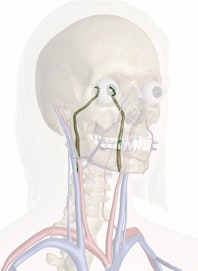Internal Carotid Artery

The internal carotid artery enters the skull and supplies the anterior part of the brain (via cerebral branches), the eye and its appendages, and sends branches to the forehead and nose. It has many curvatures in different parts of its path. When it passes through the carotid canal and the side of the body of the sphenoid bone, it has double curvature and looks like the italic letter S.
It moves up at a right angle to the pharynx and then towards the skull's base. At this point it will goes into the carotid canal, which is located in the temporal bone's petrous portion. The internal carotid artery rests on the external carotid artery's outer side at first and then it goes behind it. The internal carotid artery starts is in the superior carotid triangle and as it rises, it lays deeper, under the parotid gland, the digastric muscle's posterior belly, stylopharyngeus and stylohyoid muscles and styloid process. The posterior and occipital auricular arteries and the glossopharyngeal and hypoglossal nerves cross it.
On the outside, it is close to the pneumogastric nerve and the internal jugular veins, and around the bottom of the skull with the hypoglossal, glossopharyngeal and spinal accessory nerve. From behind, it's near the superior ganglion of the sympathetic nerve, the superior laryngeal nerve, and the rectus capitis anticus major muscle.
In an adult it is about the same size as the external carotid; however, in a child, it is larger than the vessel. Branches of the two internal carotids and the basilar artery join at the base of the brain to form a ring of blood vessels called the circle of Willis. The carotid arteries have two sensory regions in the neck: the carotid sinus and the carotid body. The carotid sinus is responsible for blood pressure and the carotid body watches the oxygen content of the blood and regulates breathing.


